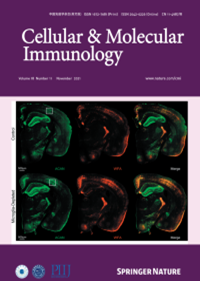Systematic mining and quantification reveal the dominant contribution of non-HLA variations to acute graft-versus-host disease
IF 19.8
1区 医学
Q1 IMMUNOLOGY
引用次数: 0
Abstract
Human leukocyte antigen (HLA) disparity between donors and recipients is a key determinant triggering intense alloreactivity, leading to a lethal complication, namely, acute graft-versus-host disease (aGVHD), after allogeneic transplantation. Moreover, aGVHD remains a cause of mortality after HLA-matched allogeneic transplantation. Protocols for HLA-haploidentical hematopoietic cell transplantation (haploHCT) have been established successfully and widely applied, further highlighting the urgency of performing panoramic screening of non-HLA variations correlated with aGVHD. On the basis of our time-consecutive large haploHCT cohort (with a homogenous discovery set and an extended confirmatory set), we first delineated the genetic landscape of 1366 samples to quantitatively model aGVHD risk by assessing the contributions of HLA and non-HLA genes together with clinical factors. In addition to identifying multiple loss-of-function (LoF) risk variations in non-HLA coding genes, our data-driven study revealed that non-HLA genetic variations, independent of HLA disparity, contributed the most to the occurrence of aGVHD. This unexpected major effect was verified in an independent cohort that received HLA-identical sibling HCT. Subsequent functional experiments further revealed the roles of a representative non-HLA LoF gene and LoF gene pair in regulating the alloreactivity of primary human T cells. Our findings highlight the importance of non-HLA genetic risk in the new era of transplantation and propose a new direction to explore the immunogenetic mechanism of alloreactivity and to optimize donor selection strategies for allogeneic transplantation.

系统的挖掘和量化揭示了非hla变异对急性移植物抗宿主病的主要贡献。
供体和受体之间的人类白细胞抗原(HLA)差异是引发强烈同种异体反应的关键决定因素,导致同种异体移植后的致命并发症,即急性移植物抗宿主病(aGVHD)。此外,aGVHD仍然是hla匹配异体移植后死亡的一个原因。hla -单倍体造血细胞移植(haploHCT)方案的成功建立和广泛应用,进一步凸显了对与aGVHD相关的非hla变异进行全景筛选的紧迫性。基于我们的时间连续的大型单倍hct队列(具有均匀的发现集和扩展的验证集),我们首先通过评估HLA和非HLA基因以及临床因素的贡献,描绘了1366个样本的遗传景观,以定量模型aGVHD风险。除了在非HLA编码基因中发现多种功能丧失(LoF)风险变异外,我们的数据驱动研究显示,非HLA遗传变异(独立于HLA差异)是导致aGVHD发生的最重要因素。这一意想不到的主要影响在接受hla相同的同胞HCT的独立队列中得到证实。随后的功能实验进一步揭示了具有代表性的非hla LoF基因和LoF基因对在调节人原代T细胞同种异体反应性中的作用。我们的研究结果强调了非hla遗传风险在移植新时代的重要性,并为探索同种异体移植反应性的免疫遗传学机制和优化供体选择策略提供了新的方向。
本文章由计算机程序翻译,如有差异,请以英文原文为准。
求助全文
约1分钟内获得全文
求助全文
来源期刊
CiteScore
31.20
自引率
1.20%
发文量
903
审稿时长
1 months
期刊介绍:
Cellular & Molecular Immunology, a monthly journal from the Chinese Society of Immunology and the University of Science and Technology of China, serves as a comprehensive platform covering both basic immunology research and clinical applications. The journal publishes a variety of article types, including Articles, Review Articles, Mini Reviews, and Short Communications, focusing on diverse aspects of cellular and molecular immunology.

 求助内容:
求助内容: 应助结果提醒方式:
应助结果提醒方式:


